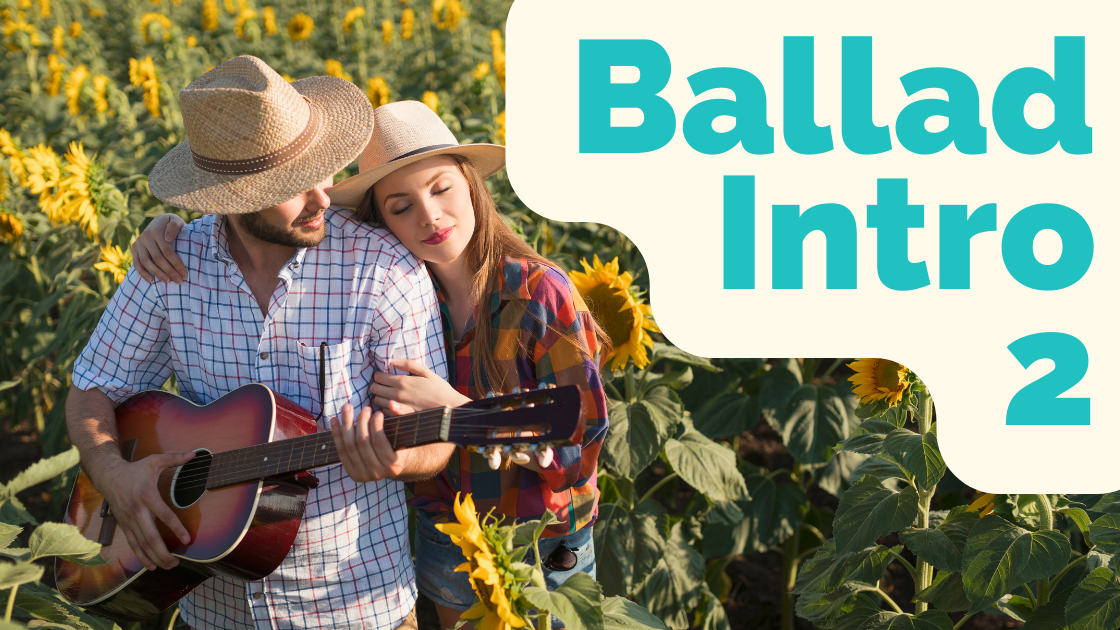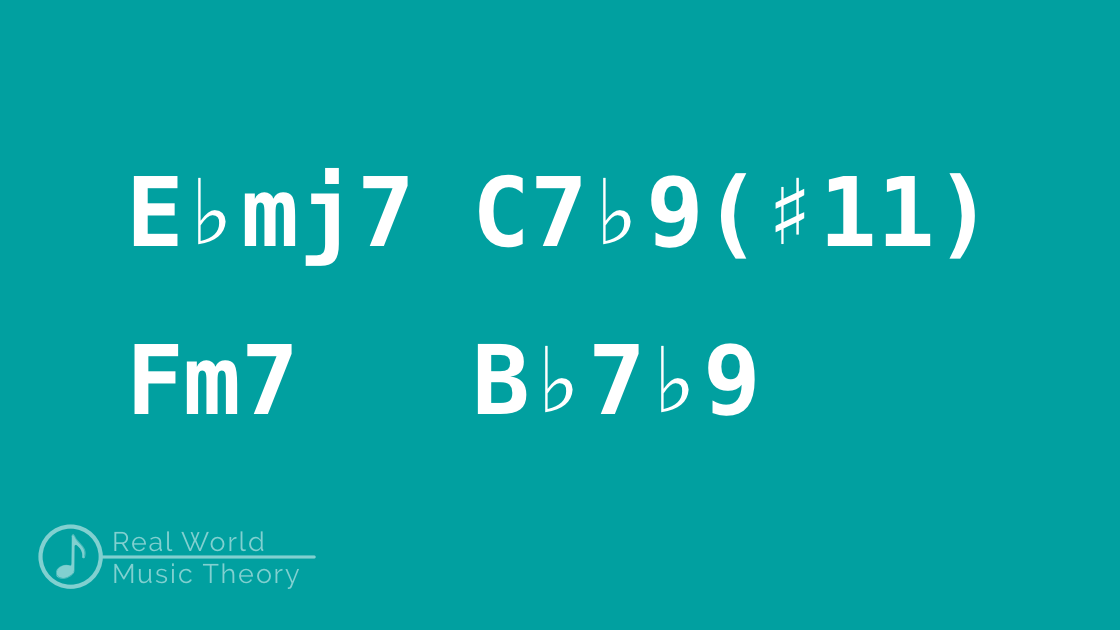Ballad intro I-VI-ii-V – great for songs in major
As a musician and songwriter, expanding your repertoire of intros and outros is essential. Discover a beautiful ballad intro using the I-VI-ii-V chord progression, perfect for songs in a major key. Learn how to use arpeggios and altered chords to create a captivating start to your music.

As a musician and songwriter you needs to have a repertoire of intros and outros. This article presents another wonderful ballad intro to add to your bag of musical tricks.
What it sounds like
Listen to the chord progression first:
It’s a beautiful progression to ease your listener into your song. The chords are almost diatonic, but they add that certain flavor of altered harmony. Let’s look at the chords in more detail.
The chords
This intro works heavily on arpeggios. Arpeggio simply means taking a chord and playing one note after the other (instead of all at once). Arpeggios can go up and down. This intro alternates between arpeggiating down and up.

The starting chord of our song is Eb major. So we establish that tonality first with Ebj7. Adding the major 7th is common in ballads. It adds a sophisticated and lush flavor to the chord. We also add a 9th for good measure – you can almost always add 9th to chords to make them more interesting. We arpeggiate down on that chord.
The Ebj7 is followed by C7b9#11. That’s a heavily altered chord. You can think about this chord as F# over C, which makes playing the thing a lot easier. The arpeggio of this is essentially an F# chord run up on the instrument.
The progression then moves to Fm7. Again we change the direction of motion by arpeggiating down on the chord. Also adding a 9th again to make the chord richer.
Finally we move to Bb7b9. Another altered dominant chord that will lead us back to the starting chord of Eb major. You can view this altered chord as a B diminished chord over Bb. But instead of running this diminished chord up in sixteenths again, we slow the arpeggio to only use eighths notes. That slowing creates a ritardando effect and leads nicely into the following Eb major chord.
It’s worth understanding all the music theory going here. Besides furthering your music theory knowledge, understanding the theory will actually help you play this progression much more easily in real world situations. So let’s dive in!
The music theory
The music theory of this progression is interesting. We look at the chords and the flow of the melody in arpeggios.
Chords
Despite of the progression being basically diatonic (meaning all chords are from the same key), the addition of altered chords adds a distinct flavor to it.
But let’s start at the beginning. Our example song is in the key of Eb major and starts on that key’s tonic chord, which is simply Eb major. Our job as songwriters and intro creators is to find a nice progression leading the audience into that Eb major tonic chord.
We start by working our way backwards from that Eb target chord. So what’s a chord leading nicely into an Eb major chord? Yes, it’s its dominant chord a fifth above. That chord is Bb7. To spice things up a little, we make this an altered dominant chord. Dominant chords are great for turning them into altered chords. In this case we add the b9 (a b natural), which is an additional leading tone towards the Eb tonic chord. We’re also adding another leading tone, but we’ll cover that in the “melody” section below.
Next we need a chord leading into our Bb7b9 dominant. Again we can find such a chord moving up a 5ths (or moving one step further in the circle of fifths). We arrive at F. Preceding a dominant chord, we often use a minor seventh chord, which makes this an Fm7.
Now we have Fm7 to Bb7b9 to Eb. With a little experience in music theory you will recognize this as a 2-5-1 progression in Eb major. So we have a strong cadence leading into our beginning of the song. While we could stop (or rather start) there, we can work our way back further.
Trying to find a chord leading into Fm7 leads us to search for the dominant again. The dominant of F is C7 – a 5th above F. To spice things up a little, we turn this dominant into an altered chord, too. We’ll make it a C7b9#11 chord. While this reads like a mouthful, it’s actually a simple chord to play. The 7, b9 and #11 are actually a b flat d flat and g flat. Just arranging these three notes makes us realize that it’s just a Gb major triad (or F# major enharmonically). So playing Gb over a C (adding in the major third e) already gives us a professional sounding C7b9#11 chord! We’ll make even more use of that Gb (or F#) chord in the melody section below.
While we could advance this game even more by working out the dominant leading to C7, we stop here. We already have three chords for our intro and we just need one more to make it an even 4 chords.
That starting chord will just be the Ebj7. We establish the key of the song by stating the tonic here. This anchors our audience into the world of the song. Adding the major 7th and also a 9th to the chord makes it sound sophisticated and rich.
Now we have four chords carefully built to grab the listener and pull them into our song. The four chords resemble a classic I-vi-ii-V progression. But we added some spice with our altered dominants. To make our intro even more persuasive, we add a little thought to the melody as well.
Melody
The melodic part of this intro has a simple melodic outline and uses arpeggios to move between corner stones of the melody.
We’ll look at the outline and the corner stones first. It all starts on a g, which is the third of Eb major. The melody also ends on a g, just an octave lower. In between these two points it moves down, up again to that same g, back down and finally up half way to the g an octave lower.

This wave-like motion creates the corner stones for all melody notes in the intro. Now let’s fill in the details.
Generally the notes move up and down in arpeggios (i.e. playing the notes of the chord one after the other). This creates a flurry of notes waving up and down beautifully to pull the audience into the beginning of the song.
The first arpeggio on the Ebj7 chord moves down from the third by outlining ab Ebj7,9 chord.
When the next chord C7b9#11 hits, we move down to the next note of that chord and then reverse our motion. Now we arpeggiate the altered dominant chord upwards. The arpeggio is actually a simple Gb (or F#) triad running up on the instrument. We run back up until we almost hit the initial note of g.
That initial g is now stated again with the chord change to Fm7. The note instantly adds the 9th to the Fm7. Again we reverse the motion. Now we run the arpeggio down on the Fm7,9 chord. This time we switch things up a little to not run to low on the instrument. After all, we want to slow down a little and target the final g after the next chord, so that we can ease the audience into a nice third on the tonic chord.
On the chord change to Bb7b9 we again move down a little to get our starting note (the b9). We reverse direction again, but this time we move upwards a little slower. This slowing down has two reasons: First it allows us to land an octave lower than where we started, second it adds a nice ritardando feel creating some tension and expectation towards the beginning of the song.
Add the end we ease the melody into the final Eb chord by moving chromatically upwards (which is our current arpeggio motion). From the f to f# to g. In terms of harmony this adds another alteration to our altered Bb7b9 chord, making it essentially a Bb7b9b13 chord. But the main purpose of that chromatic figure is to create a strong leading tone and a smooth line towards the third of the Eb chord.
That’s it. We created a nice flurry of notes with wave-like up and down motion depositing us nicely on the initial chord of the song.
Next steps
As with other intros, you should transpose this chord progression into a few keys you use commonly. You should best pick a few ballads you like and simply add this intro to each and every one. Songs starting on the major tonic chord work best for this.
Once you’re familiar with it, you should be able to recall it instantly when writing or playing a new song. Now you can begin to change the chords a little. Experiment. Use a regular minor vi chord instead of the altered dominant. Or make the final ii-V7 progression a ii-bII7 progression by doing a tritone substitution. Have fun and try new things to come up with your own variations of this song intro. And most of all: keep making awesome music!
Btw: I have another wonderful ballad intro for you.